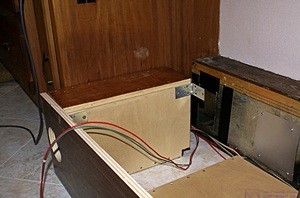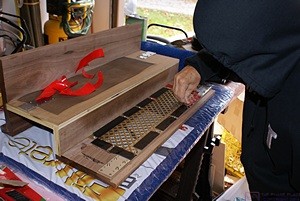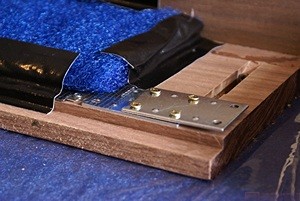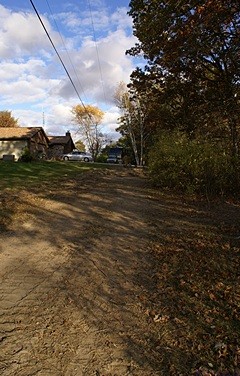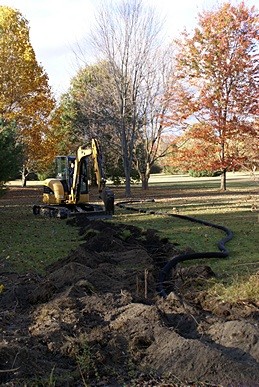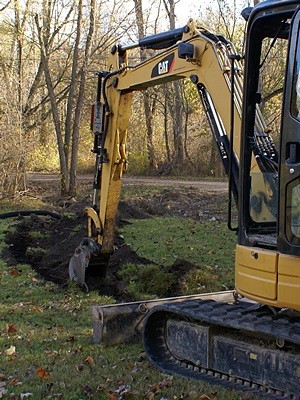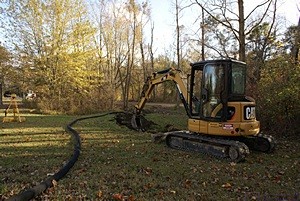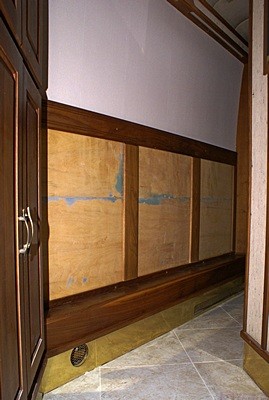Last night we removed the dining table from the back of my car and put it on the bed in the bus. We then removed the two rear seats and put them in the garage. We wanted the back of the Honda Element empty when we got up this morning as we do not usually have time to spare in the morning before driving to South Lyon for breakfast with the South Lyon Area Amateur Radio Club.
It’s always good to see our fellow hams and today was no exception. We arrived just before 8 AM and stayed for over an hour. We left around 9:15 and drove to Chuck’s shop in Novi to get the box with the two remaining lower windshields for our bus. Chuck was already there and helped us load the box into the car. The box was sized to hold five windshields but only had two in it so it was light enough for us to move by hand. I knew it would fit in my car as we had measured it on a previous visit and I had checked the dimensions against the car. We set one end on the tailgate, lifted the other end, and slid it in. We chatted for a while, and looked at a project Chuck is working in for new front window shades, before heading home.
Phil was not at our house when we got home but he had obviously been there. All of the concrete, and many of the rocks and boulders, were gone from the driveway extension area so I presumed he had loaded them in his truck and hauled them away.
The Converted Coach Owners (CCO) Halloween Rally was going on this weekend and today was the main day for activities. We had intended/hoped to go to the rally but the progress on our bus remodeling has slowed over the last couple of weeks for various reasons, all legitimate, and it was not in a condition to travel or be used. It’s not that things are not getting done; they are, just not as fast as we would like or need them to. Among other things I have not yet secured the refrigerator and pantry. We thought about driving over in the car but it was over two hours one way and we needed to spend what time we had available working on the bus and could not justify being gone. Thanksgiving does not look/feel that far away anymore. It also seemed ill-advised to be gone while Phil is here digging up the yard.
My main bus focus for today was completing the installation of the built-in sofa. We had already set the plywood seat board on a blanket on the bus kitchen floor so I had access to the inside of the base/storage box. I did not need Linda’s assistance for a while so she worked on her counted cross-stitch project. Before starting on the sofa, however, I took care of a few other minor things.
First I replaced the alkaline batteries in the TempMinder thermometers with Lithium ones. I then reset the minimum and maximum temperatures for the two remote sensors. Sensor #1 monitors the freezer and sensor #2 monitors the fresh food compartment of the bus refrigerator. The directions for the TempMinder suggest using Lithium batteries if the remote sensors will be in cold environments.
Next I got a piece of scrap SurePly underlayment to see how it would fit in the rabbited wood trim on the lower outside wall of the hallway. I inserted it fully into a corner and marked the edges with a pencil. It is approximately 3/16″ thick and fit nicely without being too tight. With a layer of veneer it should be just right. When I removed it the depth of the rabbits appeared to be 5/16″ to 3/8″. I think the underlayment will make a nice base for hardwood veneer. I will cut the panels 1/2″ wider (22-1/2″) and 1/2″ longer (28″) than the 22″ X 27-1/2″ dimensions of the framed opening and allow them to “float” just like a frame and panel door.
My last mini-task was locating the 1/4″ walnut veneered plywood we removed from the old refrigerator and measuring it to see if we had pieces big enough to panel the damaged area on the wall by the co-pilot seat. I was pleased to find that the remaining pieces are large enough for this application.
By now it was 12:30 PM and my phone reminded me that we had an RVillage Ambassadors webinar/meeting at 1 PM. Linda heated up some Amy’s Vegetable Bean Soup and made hot lentil loaf sandwiches with ketchup. Yum. We got our first snow flurries of the 2015-16 winter season during lunch and they continued off and on through the afternoon. We moved to Michigan in May 1976. It snowed on October 15th that year and we had snow on the ground every day until early April 1977. While that has not held up over the years as a “typical” southeast Michigan winter it was very different from what we grew up with in Missouri and formed our first and most lasting impression of our adopted state.
I retrieved the link for the Go To Meeting from the RVillage website and put it in my web browser. 1 PM came and went with no meeting. The meeting notice said “Saturday, October 17 at 10 AM PST” but they had clarified that was actually 10 AM PDT, which is 1 PM EDT. We decided that perhaps they really meant PST, which would be 2 PM our time. We tried again an hour later, but no meeting ever commenced.
When I finally got to work in the bus on the sofa I removed six screws, three each from two angle brackets, and pulled the entire base assembly out from the wall, giving me complete access to the HVAC duct and wiring chase. Much of the final installation of the sofa involved this duct.
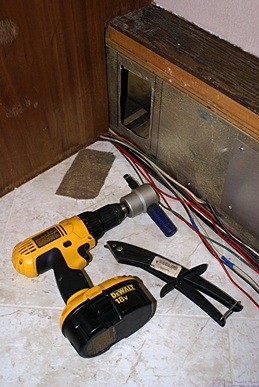
Powered and manual sheet metal nibblers with the opening Bruce just cut in the OTR HVAC duct and the piece of sheet metal that was removed.
The ends of the plywood seat rest on two boxes with open ends that also serve as plenums for air from the OTR HVAC system ducts. I needed to cut out rectangular openings in the vertical face of the duct to allow air into the back end of these boxes. I used a 1/2″ drill to create starter holes at the corners of the openings and then used a manual sheet metal nibbler and a drill-powered reciprocating nibbler, both of which I borrowed from Chuck a few weeks ago, to cut out the sheet metal. The two tools work differently but they both worked well and I was glad I had both of them for this task. The powered nibbler created a lot of small metal debris so I vacuumed the whole work area very thoroughly when I was done nibbling.
The right (forward) end of the duct also had an extra hole in it where I did not need or want one. I removed an old sheet metal patch plate and cut a new one to cover the area I needed to close off. I ended up having to pre-drill holes as I spun the heads off two of my cheap sheet metal screws. I had a heck of a time getting the shafts out, but I got it done. This was just one more example of why seemingly simple projects always take longer than they should.
Phil returned while I was working on the sofa and continued trenching in the French drain. I stopped to chat with him briefly and Linda came out to let me know she was headed to the grocery store. I then got back to my own tasks and let Phil get back to his.
The open fronts of the two plenum boxes are attached to the inside of the vertical front support, which is 3/4″ walnut veneered plywood. To get the air out of the boxes and into the coach my design called for brown plastic 4″ round louvered diffusers. They are considered “four inch” because the two inch long cylindrical pipe on the back will just fit through a 4″ diameter circular hole. (A 4″ flexible duct, like dryer duct, will also just fit over the pipe.) The visible part of the diffuser is actually 5-1/2″ in diameter.
The inside width of the plenum boxes is 4-1/4″ by design. I needed to center a 4″ hole within that space so I had to locate the center point for my 4″ hole saw very accurately side-to-side. I also wanted the hole centered vertically. Using my small square I marked the vertical midpoint on the edge of the front plywood at each end. I then measured in 2-13/16″ from the midpoint mark and used my spring-loaded center punch to mark the center of the hole. [The 2-13/16″ dimension came from half the inside width, or 2-1/8″, plus the thickness of the plywood used to make the plenums, or 11/16″.]
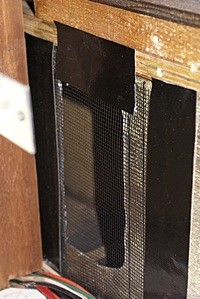
A close up view of the nylon mesh screen material used to cover the opening in the HVAC duct to keep critters that might get into the duct from getting into the support/plenum box.
I stood the boxes on their back ends so the front board was horizontal. I straddled the front board with my legs to hold it and drilled starter holes with a #6 countersink bit. I then drilled the 4″ holes with a 4″ hole saw using my 1/2″ Craftsman corded drill, being careful to have the pilot bit in the starter holes and drill perpendicular to the face of the plywood. I have had this drill for 37 years. It is very powerful and has several ways it can be gripped quite securely. It is large, heavy, and lacks the convenience of a cordless drill but when I need to use a bit with a 1/2″ shaft and/or need the torque, this is still the drill for the job. The hole saw created some sawdust so I vacuumed the whole area thoroughly when I was done drilling.
I was just finishing this work when Linda got back from the grocery store. She put the groceries away and came out to see if I needed any assistance. I already had the roll of plastic screen in the bus and she got the Gorilla Tape from the garage. I cut pieces of the screen large enough to cover the two rectangular openings in the HVAC duct and used lengths of Gorilla Tape to secure them. We then slid the base/storage assembly back into position, pushed it tight to the HVAC duct, and reattached it to the wood wire chase on top of the duct. The two support boxes and the return air box have foam weather stripping on the back edges to seal against the duct.
We picked the plywood seat up off of the kitchen floor and set it back in place but did not secure it. We left it out several inches from its original position and got a seat and back cushion from the bedroom. We experimented with different spacings and finally agreed that we need to have the seat out 4-3/4″ farther than originally designed. The current hinge board is 11/16″ plywood, 2-3/4″ wide by just under 78″ long. This board is screwed to the top of the wiring chase and to one side of the 72″ piano hinge. I will replace it with a piece that is 7-1/2″ wide by the same length. I will also have to provide some additional support for the seat side of the piano hinge as in the original design had both sides of the hinge resting on top of the wiring chase on top of the HVAC duct.
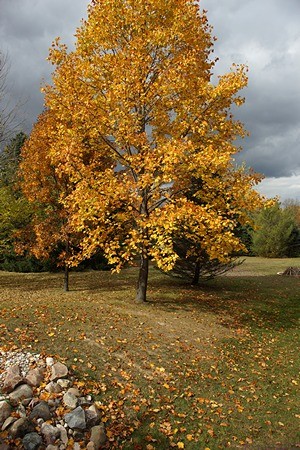
The Tulip Tree behind our house in its full fall glory. This is the first photo to be posted in this blog taken with the new Sony a99v DSLT camera.
That was the end of the interior bus work for today. By the time we were done Phil had driven his front-loader onto his flat-bed trailer and secured it so it appeared he was wrapping up for the day. I chatted with him about the project for 30 minutes before he left. Earlier in the afternoon I had found my site plan drawings for the bus barn and agreed to stake out the driveway tomorrow so we could review it first thing Monday morning.
Linda had invited Meghan and Chris for brunch tomorrow but it was not a good weekend for them as the Michigan vs Michigan State football game was taking place in Ann Arbor. Chris manages the Pizza House restaurant, and being away on football Saturday is not an option. They will come next Sunday (31st) instead.
For dinner Linda made a nice salad of mixed greens with dried cranberries, sliced almonds, and diced onions dressed with raspberry vinaigrette. The main course was pan-fried polenta with vegan puttanesca sauce. It held its heat to the last bite and was very satisfying on a cold evening. I opened a bottle of Cupcake Black Forest red wine. We have had it before and, although drier than I prefer, it went well with the meal.
After dinner I got my flashlight and checked the bus for axle/hub seal leaks by looking under the bus from the opposite side to see the inside of the wheels. I did not see anything to suggest a problem on any of the six positions and will text that information to Joe tomorrow for planning purposes as he would require a second day to work on the seals if that was needed.
We spent the last couple of hours of the day in the living room, with the fireplace turned on, reading, writing, and playing games while enjoying some red grapes for dessert. Linda got a text from her sister-in-law, Mary, with a photo of her and Ron “standing on ‘the’ corner in Winslow, Arizona.” Ron has been retired for many years but Mary only recently retired and they are on their first extended camping trip in their A-liner trailer and their first trip to the southwest U.S.
We went to bed around 10 PM. Linda fell asleep quickly while I divided my attention between cooking shows on the Detroit PBS Create channel, a concert by Eric Clapton on PBS, and working on this post.
